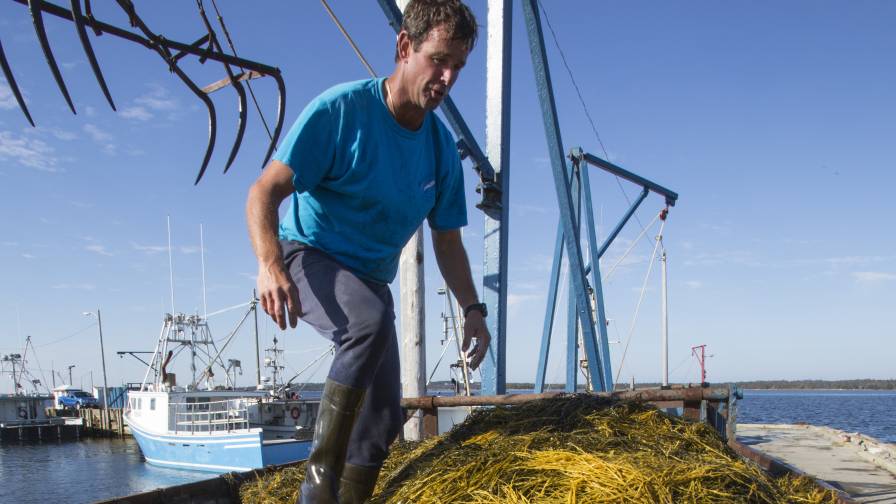Global Regulatory Review
Europe:
‘Cut Off’ by Hazard-Based Evaluations?
Makhteshim Agan’s home is Israel but it does more than 40% of its business in Europe, so it feels the continent’s growing pains of late. According to its Head of Global Regulatory Affairs, Dr. Tali Ehrlich, regulation changes in the region could affect more than half of products in the European market, and the effects could be felt around the world. The change he is referring to, of course, is the newly implemented “cut-off” criteria.
“The new regulation is driving a change in the products’ evaluation from the risk approach-based evaluation to the hazard-based evaluation,” he explains, meaning that products will be regulated based only on the intrinsic toxicity properties of the active ingredients instead of the risk posed to human and environmental health when used according to their approved label recommendations.
MAI estimates that about 10% to 15% of products currently on the market will be eliminated due to the new approach. The ultra-conservative rule does not take into consideration the reduced risk of AIs based on label-approved use of the product. For chemical companies in the region, this means that products with AIs that meet the hazard-based “cut-off” criteria will not be approved for registration renewal.
Criteria Definition Deadline Nears
As for exporters to Europe, Ehrlich explains that products could be banned from entering the region due to the cut-off criteria. “Countries like Israel, Turkey, Northern and Southern Africa, the U.S., Chile and many others will not be able to use these products on their crops anymore because the presence of residue according to the new European standards may be too high,” he explains. “This will have economic implications on the agrochemicals used around the world.” Furthermore, any AIs with two out of the three PBT (persistent, bioaccumulation, toxicity) criteria becomes what is referred to as “CfS,” or candidate for substitution, meaning it will only be re-registered for seven years instead of 10 to 12, in hopes that a less hazardous AI comes along in the meantime.
The problem, according to MAI, is that the EU Commission has worked on the list of Cfs products without consulting industry leaders and without taking into account new data which, in many cases, was developed for registration renewal but not yet submitted. “There is a high risk that a considerable number of AIs will fall under the CfS category,” warns Ehrlich. “The industry estimates about 60% of AIs registered in the EU will be affected by these changes.”
MAI says it is keeping its feet firmly planted on the ground when it comes to the future of the European agrochemical industry. “We believe that our industry is constantly evolving and continuously putting out new products; therefore the regional companies’ finances should be relatively stable,” Ehrlich says. Ehrlich believes that leaders beyond the EU are eyeing the region’s new, conservative methods as a way to reduce risk in their own areas. “It seems to be compelling to several global authorities like Brazil,” he says. “They are discussing the implementation of a similar plan, but it will greatly reduce the number of registered products in their country.”
ECPA: Interpretation Could Impact Trade
The European Union’s endocrine disruption cut-off criteria could have an impact on international trade, but it will come down to legislative interpretation that has not yet been finalized.
According to a memo from Euros Jones of the European Crop Protection Association (ECPA) regarding EU’s Regulation 1107/2009, the key plant protection product regulation, trade will be affected if the EU considers that import tolerances could not be set for active substances that have been removed from the EU market because they triggered the cut-off criteria.
“Such a decision on import tolerances may be taken as early as 2015. Raising awareness of this issue with exporting countries would be a helpful step to minimize the potential trade impact,” says Jones.
The other piece of legislation that can potentially impact pesticides trade is Regulation 396/2005, which deals with the setting of residue levels in agricultural products. Regarding products coming from outside the EU, the legislation states that specific import tolerances can be set.
While Jones said there is still no clear picture how this issue will eventually be managed by the Commission, the relevant officials have indicated they will only look to clarify the issue when the situation first arises – for example, after an active does not pass approval due to the application of the cut-off criteria.
Australia:
Legislation Overhaul Focuses on Time
The agricultural giant “down under” is undergoing some massive changes. Industry professionals in the area should expect new legislation coming into effect on July 1 that will have a significant impact on Australian agrochem players. According to Andrew Wells, research and development manager for Nufarm, the new legislation means crop input professionals must prepare now.
The process of re-registration of products is getting a facelift, as currently the process solely requires the payment of a renewal fee. Wells says that the new legislation, however, will dictate that the continuation of re-registration of a product will be contingent upon supply of satisfactory label and formulation details and “satisfactory outcome of a mini-review/literature search of the active constituent.” If a continuation is granted, Wells explains that registrations will be allowed to continue for seven to 15 years – an improvement on the annual renewal fee.
The catch, however, is that if a label or formulation is found to be unsatisfactory, the registrant will be required to submit an application to amend/update. If the results of the mini-review/literature search are unsatisfactory, the active ingredients will be placed under a full review.
Wells says that this more intensive review process may have significant consequences for “old” chemistries due to the fact that registrations could be cancelled due to insufficient contemporary data. The new legislation also sets a variety of timeframes that the Australian regulatory process lacked.
While a few will benefit from deadlines, Wells is concerned that some facets of the industry have to loosen up their review process to stay within the newly drawn lines. One such fixed timeframe was set for chemicals under review. Although it is meant to speed up the review process, Wells fears it could jeopardize how thoroughly complex formulations are reviewed. Another potentially negative timeframe development is the application decision time that is now imposed on the Australian Pesticides and Veterinary Medicines Authority (APVMA). Although full details of this period are unknown, Wells is concerned that it was overlooked by the governing bodies that a risk assessment cannot be specified in advance for innovative new products. Furthermore, Wells says that this new framework will be dependent on the development of a comprehensive risk framework, which he fears APVMA will not have in place by the July legislation launch.
Another timeframe element of the new legislations includes data protection for new AIs and products. This new legislation extends the protection period from eight to 10 years. Wells says when the new laws take effect, costs will rise in step. In addition, the large-scale overhaul could slow registration timelines, meaning delays on the path to commercialization.
Latin America:
Lack of Harmony, Over-Regulation Affect Time To Market
Time is of the essence when getting your product to the market. Being able to get it through all of the ever-changing regulations, however, can hinder even the most experienced of companies from breaking ground on innovative new tools for growers. Javier Fernandez, legal adviser and director of regulatory affairs for CropLife Latin America, describes numerous issues keeping products off shelves across the Latin American region. The common theme among them? A lack of harmony in legislation in South America.
Fernandez explains that regulatory approval backlogs prevent growers from accessing new technologies, which directly impacts their operations. “Record-high commodity prices may have offset the impact of this trend, but the key question is, ‘how long can this last?’” he says. Costa Rica, for example, has registered only a handful of novel crop protection products in the past five years, and regulatory clearance turnover in Brazil is similar. This lack of new tools is creating pressure for innovative active ingredients, Fernandez explains, but governments seem to only be concerned with putting bans in place. These bans, Fernandez says, can sometimes be cross-cutting and are issued without due process. For instance, the Dominican Republic alone banned five insecticides and restricted 22 active ingredients.
Regulating aerial spray and buffer zones is another source of contention across the region, namely in Argentina. “Local governments want to tackle the issues individually, creating a swarm of desperate proposals that raise more questions than answers,” explains Fernandez. Brazil, for example, in its rush to place restrictions on aerial sprays, targeted neonicotinoids, alleging issues with pollinators. While further investigations were ordered in Brazil, other countries in the region, namely the Andean region, started discussions about pollinators and their triggers.
Brazil has also shaken up the regulatory outlook with Anvisa’s Public Consultation #2. Fernandez explains that growth in Brazil’s record-setting $8 billion market in 2012 could be jeopardized if non-science based, cut-off criteria for evaluation are introduced. The consultation process for this new regulation slowed down toward the end of the year as internal scandals were unveiled in Anvisa, but Fernandez warns that this regulation is only delayed, and the consultation is spilling over into 2013.
Agrochemical sales volume grew at an estimated 20% rate in the region in 2012 despite a challenging regulatory environment. Brazil and Argentina remain global agricultural powerhouses. The fact that regulatory policies with a high political component have made it to the region reflects that Latin America is far from being isolated.
A review by the ECPA’s legal team determined that legally, import tolerances can still be set after an active substance is removed due to the cut-off criteria, “and any refusal to grant such an import challenge would be open to challenge.”
USA
North America: Lawsuits, Legislation and the Endangered Species Act
In the last issue of Farm Chemicals International, we sat down with Jay Vroom, president and CEO of CropLife America, who laid out what lobbyists will be rallying for leading up to the Farm Bill revisions next fall. Among other things, Vroom listed the Endangered Species Act’s direct threat to the agrochemical industry and the lawsuit surrounding it as the major regulatory issue to watch in the U.S. in the coming year.
Vroom emphasized industry professionals’ major gripe about the conflict between the Endangered Species Act (ESA) and the agricultural industry: Any changes to legislation should be firmly planted in scientific evidence, not public outcry. Now, Vroom elaborates on his mission to root legislation change in fact, explaining that conflicts in the interpretation and implementation of the ESA threaten the industry’s ability to provide crop protection chemistry to U.S. growers.
The U.S. Environment Protection Agency’s (EPA) pesticide registration actions, he explains, are subject to a duplicative review of environmental risk to endangered species through an ESA requirement for EPA to formally “consult” with the U.S. Fish and Wildlife Service and/or the National Marine and Fisheries Service. EPA and the Services disagree on fundamental legal and scientific policy matters related to their respective obligations under ESA and the Federal Insecticide, Fungicide and Rodenticide Act, the governing law for crop protection products. These disagreements and lack of a workable consultation process, Vroom explains, have opened the door to legal challenges, particularly by activist organizations that prefer regulation via litigation.
One such legal challenge was in the 2011 filing by the Center for Biological Diversity and Pesticide Action Network North America against EPA, alleging that the agency failed to properly consult with the Services.
The lawsuit, which many industry professionals refer to as the “mega-suit” due to its size, involves approximately 380 chemicals and their alleged impact on 214 species. If successful, the mega-suit would restrict valuable crop protection and public health products from American growers and consumers. This is the first case that is national in scope, and the 380 chemicals in question represent more than half of the U.S. chemical industry’s entire portfolio of active ingredients.
CropLife America was granted intervener status in the case and has since filed a motion to dismiss the mega-suit; EPA has also filed a similar motion to dismiss the casein hopes to make headway. A hearing on these motions has been scheduled for this month.
The lack of demand for scientific evidence in the current legislation, however, will continue to pose the risk of future, similar lawsuits regardless of the outcome of the mega-suit.
The legal uncertainty and cost to all parties associated with such lawsuits support the widespread calls for reform this valuable program desperately needs. Vroom says that the crop protection industry will continue to work closely with legislators as changes are being propsed leading up to the Farm Bill overhaul to build support for long-term statutory and regulatory solutions strongly rooted in scientific evidence.
Asia:
Buckling Down
Southeast Asia is battling layers of regulatory transition. Six countries are in varying stages of change to their pesticide registration framework, and the lion’s share of amendments will require more rigorous data submission for crop protection companies.
Indonesia is amid the most immediate transformation as regulators consider newly drafted regulations for the registration of crop protection products. The move toward more internationally accepted standards has been a priority of national governments that want to create stricter environmental standards, better agriculture practices and preserve key trading partners, especially European countries that operate under REACH standards.
The changes will include more rigorous field trial criteria and longer-term toxicity studies for unintended species and the environment. The rules are expected to gain final approval early this year. Another addition to the new rule: Applicants must have a facility in Indonesia to qualify for a registration permit.
“The new rules will be good for our country,” CropLife Indonesia Executive Director Deddy Djunaidi said at the FCI Trade Summit in Jakarta on Dec. 3, just days after the draft rule had been submitted to regulators for final approval. “There will be more data requirements based on environmental impact, and I believe it will improve farmer practices (because they will be using more rigorously tested products.”
In the past year, about 320 new rules have been approved. Thousands still remain in limbo. Thailand overhauled its regulatory systems to mirror more stringent international rules last year, and other countries in the ASEAN trade bloc are following quickly, especially as talks continue to progress on registration harmonization. Unusually, Thailand set an expiry date (Aug. 22, 2011) for all registrations, which created a massive bottleneck as all products were forced to be re-registered at the same time.
Conversely, Indonesia plans to re-register products as they expire instead of setting a cut-off date. Malaysia and Vietnam are next in line to adopt new standards. Their respective CropLife associations have been working with regulators, private industry and other stakeholders to draft similar rules, which are expected to be reviewed for final regulatory approval in 2013.
Philippines is also planning to amend to its pesticide registration framework, although the changes will be less comprehensive than those made in Thailand and Cambodia in 2011, or the pending changes in Indonesia.






